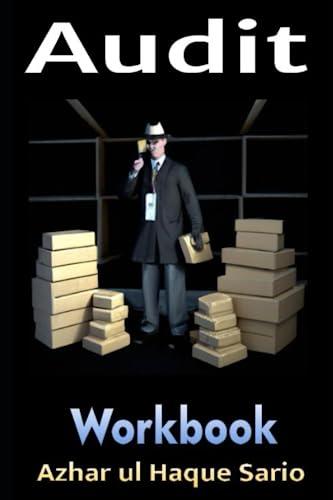Question
Question 4: Anticipated unit sales are January, 5,000; February, 4,000; and March 8,000. Finished goods are consistently maintained at 80% of the following month's sales.
Question 4:
Anticipated unit sales are January, 5,000; February, 4,000; and March 8,000. Finished goods are consistently maintained at 80% of the following month's sales. If units cost $10 each to produce, how much is February's total cost of production?
a. $0
b. $40,000
c. $72,000
d. $80,000
Question 5:
Total production of 1,000 units of finished goods required 3,900 actual hours at $12 per hour. The standard is 4 hours per unit of finished goods, at a standard rate of $11 per hour. Which of the following statements is true?
a. The labor rate variance is $3,900 favorable.
b. The labor rate variance is $4,000 unfavorable.
c. The labor efficiency variance is $1,100 favorable.
d. The labor efficiency variance is $1,100 unfavorable.
Question 6:
If beginning work in process was 600 units, 1,400 additional units were put into production, and ending work in process was 500 units, how many units were completed?
a. 500
b. 900
c. 1,400
d. 2,000
e. 1500
Question 7:
Frick Company had no beginning inventory and adds all materials at the very beginning of its only process. Assume 10,000 units were started, and 5,000 units completed. Ending work in process is 60% complete. The cost per equivalent unit of material is:
a. $1.00 if total material cost is $3,000.
b. $1.00 if total material cost is $5,000.
c. $1.00 if total material cost is $8,000.
d. $1.00 if total material cost is $10,000.
Question 8:
Assume that actual overhead consisted of $30,000 for indirect labor, $20,000 for indirect material, and $10,000 for depreciation of factory equipment. Based on the preset rates, $65,000 of overhead was applied to work in process.
a. Overhead is underapplied.
b. This is viewed as an unfavorable situation.
c. There will be a $5,000 debit balance in Factory Overhead.
d. All of the above.
Question 9:
The contract interest rate for bonds:
A. must equal the effective interest rate.
B. is greater than the effective interest rate when bonds are issued at a premium.
C. has no relation to the cash flow associated with a particular bond.
D. will fluctuate over the life of a bond.
Question 10:
Frick Corporation issued $100,000 of 7%, 15-year bonds on June 1, 2014 (dated April 1 2014) at 101 plus accrued interest, which is paid on April 1 and October 1. The proper entry to record issuance of the bonds includes a debit to Cash for:
a. $100,000.
b. $101,000.
c. $101,167.
d. $102,167.
Question 11:
Which of the following statements about treasury stock is true?
a. Excess of the sales price over cost should be credited to retained earnings.
b. Gains are not recorded on treasury stock transactions but losses are.
c. Losses on treasury stock transactions are recorded in income.
d. Reacquiring treasury stock causes stockholders equity to decrease.
Question 12:
Frick Company has 100,000 shares of common stock outstanding. On April 15, the board declared a $.30 dividend to be paid to stockholders of record on May 4. The dividend was distributed on May 15. The proper journal entry for Frick Company on May 15 does not include:
a. a credit to Dividends Payable for $30,000.
b. a debit to Dividends for $30,000.
c. a credit to Cash for $30,000.
Step by Step Solution
There are 3 Steps involved in it
Step: 1

Get Instant Access to Expert-Tailored Solutions
See step-by-step solutions with expert insights and AI powered tools for academic success
Step: 2

Step: 3

Ace Your Homework with AI
Get the answers you need in no time with our AI-driven, step-by-step assistance
Get Started


